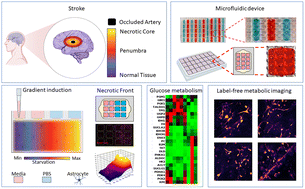Microfluidic device with reconfigurable spatial temporal gradients reveals plastic astrocyte response to stroke and reperfusion†
Abstract
As a leading cause of mortality and morbidity, stroke constitutes a significant global health burden. Ischemic stroke accounts for 80% of cases and occurs due to an arterial thrombus, which impedes cerebral blood flow and rapidly leads to cell death. As the most abundant cell type within the central nervous system, astrocytes play a critical role within the injured brain. We developed a novel microphysiological platform that permits the induction of spatiotemporally controlled nutrient gradients, allowing us to study astrocytic response during and after transient nutrient deprivation. Within 24 h of inducing starvation in the platform, nutrient deprivation led to multiple changes in astrocyte response, from metabolic perturbations to gene expression changes, and cell viability. Furthermore, we observed that nutrient restoration did not reverse the functional changes in astrocyte metabolism, which mirrors reperfusion injury observed in vivo. We also identified alterations in numerous glucose metabolism-associated genes, many of which remained upregulated or downregulated even after restoration of the nutrient supply. Together, these findings suggest that astrocyte activation during and after nutrient starvation induces plastic changes that may underpin persistent stroke-induced functional impairment. Overall, our innovative device presents interesting potential to be used in the development of new therapies to improve tissue repair and even cognitive recovery after stroke.



 Please wait while we load your content...
Please wait while we load your content...